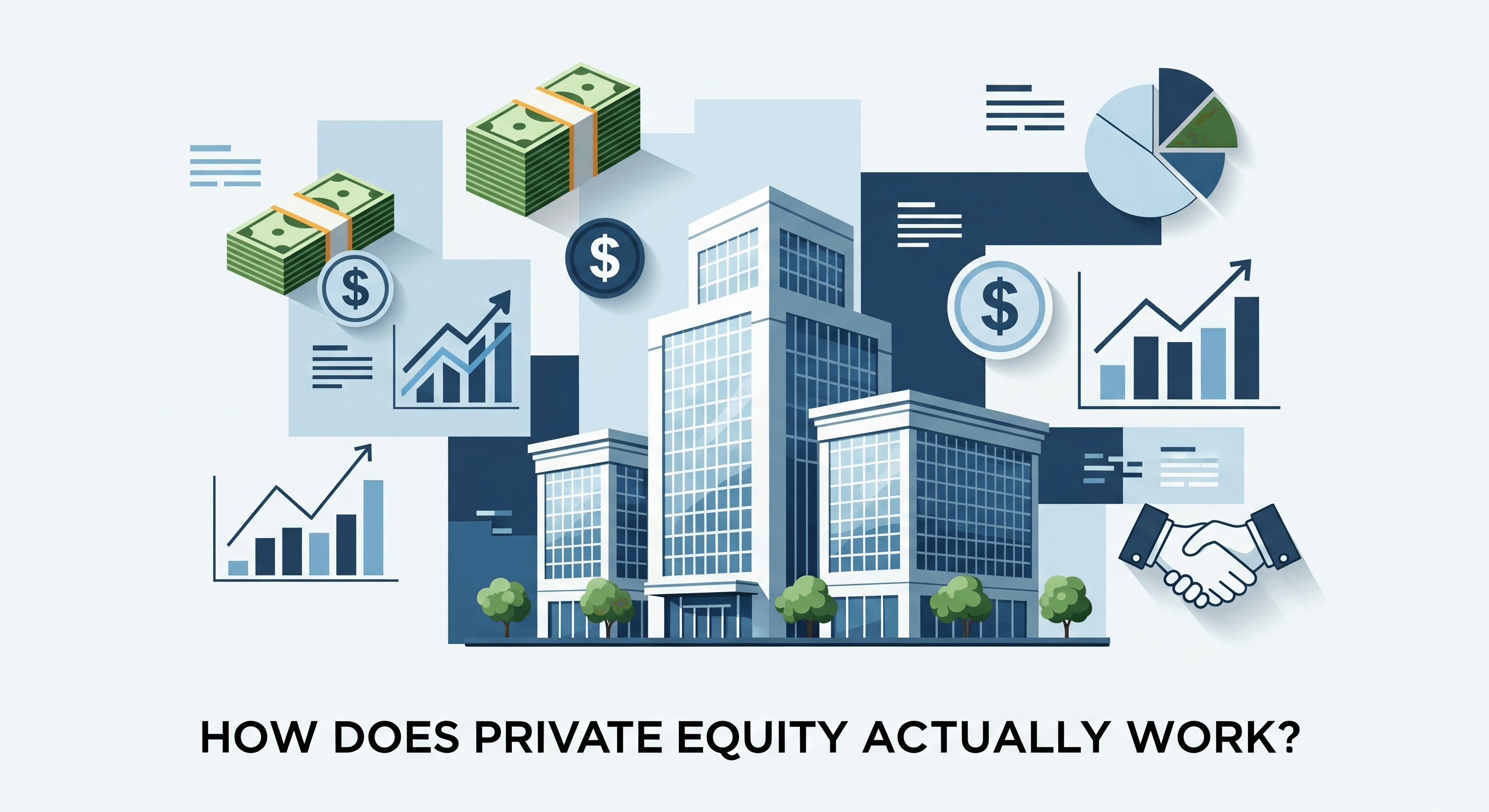Introduction
Have you ever wondered who really owns your favorite hotel, toy brand, or even popular online platforms? You might be surprised to learn that companies like Hilton Hotels, Ancestry.com, and even Legoland have all been owned by private equity firms. These firms are some of the most powerful players in global finance, yet most people have no clue what they actually do.

So, how does private equity actually work? In this article, I’ll break it down for you in simple terms. We’ll explore where it came from, how it makes investors rich, the strategies private equity firms use, and the controversies around them. By the end, you’ll finally understand the financial machine that quietly shapes our world.
What Is Private Equity?
At its core, private equity is about investing in companies that are not publicly traded on the stock market. Instead of raising money by selling shares to the public, a company can sell part of its ownership to private investors. These investors are usually large firms, not individuals like you and me.
Private equity firms buy companies, try to improve them, and later sell them at a higher price. They don’t plan to hold onto the businesses forever, they’re always aiming for a profitable exit.
Think of it like flipping houses: you buy, fix up, and sell for more. But in this case, instead of houses, they’re flipping billion-dollar companies.
The Four-Step Private Equity Model

Private equity deals usually follow a four-step process:
- Raise Funds: Firms collect money from outside investors like pension funds, wealthy individuals, and even governments. This money goes into a special investment fund.
- Buy Companies: The firm uses the fund to purchase businesses it believes can be improved.
- Improve Profitability: Once acquired, the firm restructures operations, sometimes bringing in new leadership, cutting costs, upgrading technology, or expanding into new markets.
- Sell for Profit: After 5–10 years, the firm sells the company. This could happen through:
- An IPO (initial public offering)
- Selling to another company
- Selling to another private equity firm
If the plan works, both the firm and its investors make massive returns.
A Brief History of Private Equity

Private equity isn’t new, it has roots stretching back over a century.
- Early 1900s: Business tycoons like J.P. Morgan and the Rockefellers were already using investor money to buy and merge companies, creating empires.
- Post-World War II: Harvard professor Georges Doriot founded ARDC in 1946, often considered the first true venture capital firm. His $70,000 investment in Digital Equipment Corporation grew into $355 million when it went public.
- 1980s Boom: Private equity shifted toward buying established companies instead of startups, leading to the rise of leveraged buyouts (LBOs).
- 1990s–2000s: Pension funds and even governments started pouring money into private equity, making it mainstream.
- Today: Firms like Blackstone, Carlyle, and Apollo manage trillions of dollars, owning pieces of nearly every industry you can think of.
Types of Private Equity Strategies
Private equity isn’t just one method, it includes several different strategies. Let’s break them down.
1. Leveraged Buyouts (LBOs)

This is the most famous type of private equity deal. In an LBO, a firm buys a company using a combination of borrowed money and investor funds. The twist? The loan is backed by the assets of the company being purchased.
- Success Story: Blackstone’s acquisition of Hilton Hotels in 2007. They restructured the company, shifted to a franchising model, injected $800 million, and eventually made around $14 billion in profit when Hilton went public again.
- Failure Story: Toys “R” Us. In 2005, private equity firms bought it using huge debt but failed to reinvest in the business. Without adapting to e-commerce, the company collapsed, shutting down over 800 stores.

???? Lesson: LBOs can create huge profits but also destroy companies if not managed wisely.
2. Growth Equity
Growth equity is like the safer cousin of venture capital. Instead of risky startups, firms invest in already successful companies that need money to expand further.
Example: TikTok’s parent company, ByteDance, received growth equity from firms like KKR and General Atlantic. This funding helped TikTok scale globally at lightning speed.

3. Venture Capital
Venture capital (VC) focuses on early-stage startups with high potential but also high risk.
- Big Wins: Sequoia Capital invested early in Airbnb, Google, and WhatsApp, earning billions.
- Big Losses: Venture firms lost hundreds of millions in failed startups like Theranos and FTX.
VC is all about betting on the future. Sometimes you win big, other times you lose it all.
4. Distressed Investing

This is the controversial side of private equity. Firms buy struggling or bankrupt companies at a discount and try to turn them around.
Sometimes this works: Capita bought Game UK and made it 12 times more valuable within two years.
Other times, it fails: in 2024, over 110 private equity-backed companies filed for bankruptcy.
???? Critics argue distressed investing often prioritizes short-term profits over workers’ jobs and long-term survival.
How Do Private Equity Firms Make Money?

Here’s the real question: if private equity firms don’t put up all their own money, how are they getting so rich?
- Management Fees: Firms charge investors around 2% of the total fund size every year just to manage it. For a $10 billion fund, that’s $200 million annually before any deals happen.
- Performance Fees (Carried Interest): Firms also keep 20% of the profits they generate for investors.
- Debt Advantages: Because deals often involve borrowing, the acquired company pays back the loans, not the firm. Plus, interest is tax-deductible, boosting profitability.
- Exit Profits: When the firm sells the company at a higher value, the gains can multiply 5–10x their original investment.
This is why firms like Blackstone and Apollo control trillions of dollars and keep growing richer and more powerful.
The Criticism of Private Equity

Not everything about private equity is glamorous. Critics point out:
- Job Cuts: Many deals involve massive layoffs to reduce costs.
- Excessive Debt: Some firms burden companies with unsustainable loans.
- Short-Term Focus: Quick profits can come at the cost of long-term stability.
The Toys “R” Us collapse is often cited as an example of private equity gone wrong, where financial engineering prioritized investor returns over saving a beloved retail brand.
Why Private Equity Still Thrives
Despite criticism, private equity continues to grow because:
- Investors (pension funds, endowments, etc.) get higher returns than public markets.
- Firms bring operational expertise to make businesses more efficient.
- They diversify across industries: from hotels to tech to healthcare.
Conclusion

So, how does private equity actually work? At its heart, it’s a financial engine that buys companies, improves them (sometimes aggressively), and sells them for a profit. Along the way, firms make money through management fees, performance fees, and clever use of debt.
It’s a high-risk, high-reward game that has made firms like Blackstone, Carlyle, and Apollo some of the most powerful institutions in the world. Love it or hate it, private equity isn’t going away anytime soon, it’s shaping the businesses you use every single day.
If you enjoyed this guide and want more insights on money, investing, and building wealth, visit Forcefall.com for more in-depth articles and resources.















